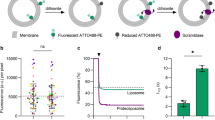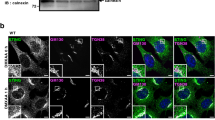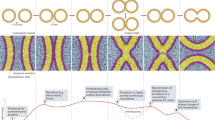Abstract
THE existence of a membrane-bound enzyme which catalyses disulphide interchange has previously been reported1–3. The activity of this enzyme in isolated “rough” fractions of the endoplasmic reticulum is masked when polysomes are attached to the membrane and is observed only when they are removed with, for example, EDTA or aflatoxin B1 (refs. 2 and 3). The same enzyme is also present in fully active form in the “smooth” fractions of the endoplasmic reticulum, but if these are incubated in the presence of polysomes and an appropriate steroid hormone, the enzyme activity decays in time-dependent fashion3.
This is a preview of subscription content, access via your institution
Access options
Subscribe to this journal
Receive 51 print issues and online access
$199.00 per year
only $3.90 per issue
Buy this article
- Purchase on Springer Link
- Instant access to full article PDF
Prices may be subject to local taxes which are calculated during checkout
Similar content being viewed by others
References
Goldberg, R. F., Epstein, C. J., and Anfinson, C. B., J. Biol. Chem., 238, 628 (1963).
Williams, D. J., Gurari, D., and Rabin, B. R., FEBS Lett., 2, 133 (1968).
Williams, D. J., and Rabin, B. R., FEBS Lett., 4, 103 (1969).
Author information
Authors and Affiliations
Rights and permissions
About this article
Cite this article
JAMES, D., RABIN, B. & WILLIAMS, D. Role of Steroid Hormones in the Interaction of Polysomes with Endoplasmic Reticulum. Nature 224, 371–372 (1969). https://doi.org/10.1038/224371a0
Received:
Issue Date:
DOI: https://doi.org/10.1038/224371a0
This article is cited by
-
The in vitro reconstitution of a functional rough membrane active in protein synthesis
Molecular Biology Reports (1975)
-
Studies on the cytophysiology of the fat body of the American silkmoth
Zeitschrift f�r Zellforschung und Mikroskopische Anatomie (1972)
-
Sex Specific Binding of Steroid Hormones to Microsomal Membranes of Rat Liver
Nature New Biology (1971)
Comments
By submitting a comment you agree to abide by our Terms and Community Guidelines. If you find something abusive or that does not comply with our terms or guidelines please flag it as inappropriate.



